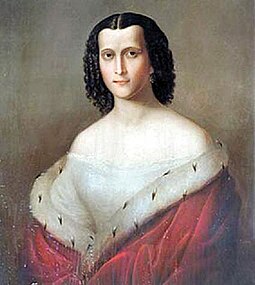Nino, Princess of Mingrelia
| Nino | |
|---|---|
 | |
| Princess of Mingrelia | |
| Tenure | 1791/94–1802 1802–1804 |
| Born | 15 April 1772 Tiflis, Kingdom of Kartli-Kakheti |
| Died | 30 May 1847 Saint Petersburg, Russian Empire |
| Burial | Church of St. John Chrysostom, Alexander Nevsky Lavra |
| Spouse | Grigol Dadiani |
| Issue among others... | Levan V Dadiani |
| Dynasty | Bagrationi dynasty |
| Father | George XII of Georgia |
| Mother | Ketevan Andronikashvili |
| Religion | Georgian Orthodox Church |
Nino (
Early life
Princess Nino was born in
Regency
Upon Grigol Dadiani's sudden death on 23 October 1804, Princess Nino became more prominently involved in the politics of Mingrelia. She immediately accused the rival nobles of having poisoned the prince and requested from the Russian commander in Georgia, Prince
The regency council under the presidency of Princess Nino also included Prince
Princess Nino followed the pro-Russian policy of her late husband. During the
Retirement to Russia

In 1811, Nino was sidelined from the government of Mingrelia. She was recalled to St. Petersburg, where she was appointed a
Princess Nino's only surviving portrait, produced by an unknown artist during her St. Petersburg years, was purchased in 2010 by the
Children
Prince Grigol and Princess Nino had six children, two sons and four daughters:[7]
- Princess Ketevan (born 1792), who married first Manuchar Shervashidze, Prince of Samurzakano (died 1813), and then, in 1823, Rostom-Bey, son of Kelesh Ahmed-Bey Shervashidze, Prince of Abkhazia. A grandson of her first marriage was Prince Giorgi Shervashidze (1847–1918), Governor of Tiflis, known for his persecution of the doukhobors in 1895.
- Prince Levan (1793–1846), Sovereign Prince of Mingrelia (1804–1840).
- Princess Mariam (born 1794), who was married firstly to Prince Giorgi Eristavi of Guria and secondly, c. 1810, to Prince Rostom (Tato), son of Beri Gelovani, Lord of Lechkhumi.
- Princess Elene (born 1795), who was married firstly to Prince David Gurieli (died 1833), son of Giorgi V Gurieli, and secondly to Prince Giorgi Mikeladze.
- Princess Ekaterine (born 1797), who married in 1810 Colonel Prince Beglar (Petre) Jambakur-Orbeliani(1776–1819), son of Prince Zaal Orbeliani.
- Prince Giorgi (1798–c. 1851), Major-General of the Russian army. He married, at Ryazan in 1839, Countess Elizaveta Pahlena, daughter of General Count Pavel Pahlen, and had no issue.
Ancestry
| Ancestors of Nino, Princess of Mingrelia | ||||||||||||||||||||||||||||||||||||||||||||||||||||||||||||||||||||||||||||||||||||||||||||||||||||||||||||||||||||||||||||||||||||||||||||||||||||||||||||||||||||||||||||||||||||||||||||||||||||||||||||||||||||||||||||||||||||||||||||||||||||||||||||||||||||||||||||||||||||||||||||||||||||||||||||||||||||||||||||||||||||||||||||||||||||||||||||||||||||||||||||||||||||||||||||||||||||||||||||
|---|---|---|---|---|---|---|---|---|---|---|---|---|---|---|---|---|---|---|---|---|---|---|---|---|---|---|---|---|---|---|---|---|---|---|---|---|---|---|---|---|---|---|---|---|---|---|---|---|---|---|---|---|---|---|---|---|---|---|---|---|---|---|---|---|---|---|---|---|---|---|---|---|---|---|---|---|---|---|---|---|---|---|---|---|---|---|---|---|---|---|---|---|---|---|---|---|---|---|---|---|---|---|---|---|---|---|---|---|---|---|---|---|---|---|---|---|---|---|---|---|---|---|---|---|---|---|---|---|---|---|---|---|---|---|---|---|---|---|---|---|---|---|---|---|---|---|---|---|---|---|---|---|---|---|---|---|---|---|---|---|---|---|---|---|---|---|---|---|---|---|---|---|---|---|---|---|---|---|---|---|---|---|---|---|---|---|---|---|---|---|---|---|---|---|---|---|---|---|---|---|---|---|---|---|---|---|---|---|---|---|---|---|---|---|---|---|---|---|---|---|---|---|---|---|---|---|---|---|---|---|---|---|---|---|---|---|---|---|---|---|---|---|---|---|---|---|---|---|---|---|---|---|---|---|---|---|---|---|---|---|---|---|---|---|---|---|---|---|---|---|---|---|---|---|---|---|---|---|---|---|---|---|---|---|---|---|---|---|---|---|---|---|---|---|---|---|---|---|---|---|---|---|---|---|---|---|---|---|---|---|---|---|---|---|---|---|---|---|---|---|---|---|---|---|---|---|---|---|---|---|---|---|---|---|---|---|---|---|---|---|---|---|---|---|---|---|---|---|---|---|---|---|---|---|---|---|---|---|---|---|---|---|---|---|---|---|---|---|---|---|---|---|---|---|---|---|---|---|---|---|---|---|---|---|---|---|---|---|---|---|---|---|---|---|---|---|
| ||||||||||||||||||||||||||||||||||||||||||||||||||||||||||||||||||||||||||||||||||||||||||||||||||||||||||||||||||||||||||||||||||||||||||||||||||||||||||||||||||||||||||||||||||||||||||||||||||||||||||||||||||||||||||||||||||||||||||||||||||||||||||||||||||||||||||||||||||||||||||||||||||||||||||||||||||||||||||||||||||||||||||||||||||||||||||||||||||||||||||||||||||||||||||||||||||||||||||||
References
- ISBN 0850110297.
- ISSN 1512-3154.
- ^ a b Polovtsov (2009). "Дадиан, княгиня Нина Георгиевна" [Dadian, Princess Nina Georgiyevna]. Большая биографическая энциклопедия [Great Biographical Encyclopaedia] (in Russian).
- ^ ISBN 0312229909.
- ^ "Nikolas (Didi Niko) Dadiani (1764-1834)". Dadiani Dynasty. Smithsonian Institution in association with National Parliamentary Library of Georgia. 2009. Archived from the original on 18 October 2011. Retrieved 4 May 2013.
- ^ Lomidze, Eka (23 August 2010). "დედოფლის დაბრუნება" [The Queen's return]. Kviris Palitra (in Georgian). Retrieved 4 May 2013.
- ^ Dumin, S.V., ed. (1996). Дворянские роды Российской империи. Том 3. Князья [Noble families of the Russian Empire. Volume 3: Princes] (in Russian). Moscow: Linkominvest. p. 54.
Further reading
- მ. დუმბაძე, დასავლეთ საქართველო XIX საუკუნის პირველ ნახევარში, თბილისი, 1957
- მ. ბერძენიშვილი, მასალები XIX საუკუნის პირველი ნახევრის ქართული საზოგადოებრიობის ისტორიისათვის, ტომი II, თბილისი, 1983
- მ. რეხვიაშვილი, იმერეთი XVIII საუკუნეში, თბილისი, 1982
- თამარ პაპავა, დიდი სახეები პატარა ჩარჩოებში, თბილისი, 1990
- Акты, собранные Кавказской Археографической Комиссией, ред. Ад. Берже, т.I, Тифлис, 1866
- Акты, собранные Кавказской Археографической Комиссией, ред. Ад. Берже, т.III, Тифлис, 1869
- Акты, собранные Кавказской Археографической Комиссией, ред. Ад. Берже, т.IV, Тифлис, 1870
